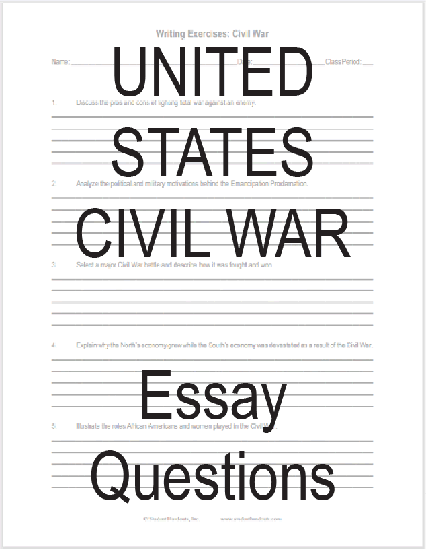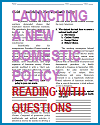| U.S. Civil War Writing Exercises |
|---|
| www.studenthandouts.com ↣ U.S. History ↣ U.S. Civil War ↣ U.S. Civil War Worksheets |
 |
   |
|
Click here to print. Answers will vary. 1. Discuss the pros and cons of fighting total war against an enemy. 2. Analyze the political and military motivations behind the Emancipation Proclamation. 3. Select a major Civil War battle and describe how it was fought and won. 4. Explain why the North's economy grew while the South's economy was devastated as a result of the Civil War. 5. Illustrate the roles African Americans and women played in the Civil War. The American Civil War had divergent economic impacts on the North and the South, leading to the growth of the Northern economy and the devastation of the Southern economy. Several key factors contributed to these disparate outcomes. Industrialization vs. Agriculture: The North was already in the midst of industrialization before the war. It had a well-established manufacturing base, a growing railroad network, and a diversified economy. The war provided a boost to Northern industries as they produced weapons, uniforms, and supplies for the Union Army. The South, on the other hand, relied heavily on agriculture, particularly cotton cultivation. It lacked the industrial infrastructure of the North and was primarily agrarian. The war disrupted Southern agriculture as plantations were abandoned or destroyed, and slave labor was emancipated. Blockades and Trade: The Union Navy established a blockade of Southern ports, severely restricting the South's ability to export its agricultural products and import essential goods. This blockade allowed Northern industries to expand to meet the demands of the war. The Southern economy was heavily dependent on cotton exports, and the blockade cut off this vital source of income. The lack of access to foreign markets for cotton hurt the South's economic prospects. Destruction and Scorched Earth Tactics: Large parts of the South, especially areas near battlefields, experienced significant physical destruction due to the war. General Sherman's "March to the Sea" in 1864 exemplified a strategy of "total war" that aimed to cripple the Southern economy by destroying infrastructure and resources. Loss of Slave Labor: Emancipation of slaves during and after the war had profound economic implications. Slave labor had been the backbone of Southern agriculture, and its loss greatly impacted the productivity of Southern farms and plantations. Financing the War: The North had a more developed financial system and was better able to finance the war through mechanisms such as bonds and taxes. The federal government also printed paper currency (greenbacks) to fund the war effort. The Confederate government faced significant financial challenges and resorted to printing paper money as well. However, rampant inflation eroded the value of Confederate currency, causing economic instability. Emancipation and Labor Mobility: Emancipation allowed African Americans to move away from plantations and seek employment in other industries or regions. This labor mobility disrupted the plantation system further. Economic Modernization in the North: The demands of the war led to innovations and modernization in various industries, including manufacturing, transportation, and communication. The war acted as a catalyst for economic growth and diversification in the North. In the aftermath of the Civil War, the North's economy continued to expand, while the South faced significant challenges in rebuilding its economy, infrastructure, and social order. The war had lasting economic consequences, with the North solidifying its position as an industrial powerhouse, while the South struggled to recover from the devastation and adapt to the end of slavery. |
| www.studenthandouts.com ↣ U.S. History ↣ U.S. Civil War ↣ U.S. Civil War Worksheets |








